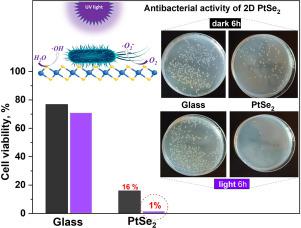Applied Surface Science ( IF 6.3 ) Pub Date : 2022-11-03 , DOI: 10.1016/j.apsusc.2022.155534 Nadia Todorova , Nikolay Minev , Vera Marinova , Krastyo Buchkov , Vladimira Videva , Rosen Todorov , Peter Rafailov , Velichka Strijkova , Vassilis Psycharis , Tatiana Giannakopoulou , Ilias Papailias , Nikolaos Ioannidis , George Mitrikas , Dimitre Dimitrov , Christos Trapalis

|
PtSe2, an emerging two-dimensional (2D) transition metal dichalcogenide (TMD), has been considered as excellent electrochemical material however its photocatalytic properties are still unexplored. In the present work, antibacterial activity of few-layer PtSe2 coatings on glass substrate against Escherichia coli in dark and light irradiation conditions is reported. 2D PtSe2 layers were synthesized by selenization of pre-deposited Pt films using thermally assisted conversion (TAC) method. PtSe2 coatings with three different thicknesses were prepared by varying the Pt deposition time (Pt 3 s, Pt 8 s and Pt 10s), afterwards estimated by ellipsometric measurements to 7 nm, 9 nm and 12 nm, respectively. The X-Ray diffraction (XRD) patterns showed the diffraction peaks characteristic for PtSe2 with improving crystallinity when increasing the Pt deposition time. Similar tendency of increasing roughness was detected by measuring the surface topology using Atomic force microscopy (AFM). The Raman spectra revealed typical PtSe2 modes, while a decrease of Se/Pt ratio and a transition from p-doped to n-doped PtSe2 for longer Pt deposition times was found by X-ray photoelectron spectroscopy (XPS) analysis. Examination of the PtSe2 band gap by spectroscopic ellipsometry showed a decrease from 0.77 to 0.64 eV upon increase of the Pt deposition time, well correlated with the UV-VIS transmitted spectra. Formation of reactive oxygen species (ROS), mainly hydroxyl radicals (•OH) on the PtSe2 surface under light irradiation was demonstrated by EPR analysis. The antibacterial activity of PtSe2 coatings was investigated applying ISO standard procedure for semiconducting photocatalytic materials: (i) in dark, the antibacterial activity increased with the increase of Pt deposition time and the viability of the bacteria was reduced to 30% (Pt 3 s) and 15% (Pt 10s) after treatment for 6 h. The effect was attributed to the increasing film thickness, roughness and surface coverage which facilitate the mechanical destruction of the bacteria cell. (ii) under light irradiation, the activity of PtSe2 (Pt 3 s) was similar to that in dark showing low sensitivity to light. On the contrary, the PtSe2 (Pt 8 s) and (Pt 10s) appeared very effective under light, with the bacteria viability after 6 h being only 7.3% and 1.2%, respectively. The observed photo-induced antibacterial activity was related to the synergy of several parameters, i.e. high crystallinity, semiconductor behavior and chemical composition. The present work opens the way for further investigation of PtSe2 as photoactive antibacterial material, the mechanism of its antibacterial activity and the possibility for application as antibacterial coating on transparent low-cost substrates.
中文翻译:

具有抗菌活性的二维 PtSe2 涂层,具有抗菌活性的二维 PtSe2 涂层
PtSe 2是一种新兴的二维(2D)过渡金属二硫属化物(TMD),已被认为是优良的电化学材料,但其光催化性能仍有待探索。在目前的工作中,报道了玻璃基板上的少层 PtSe 2涂层在黑暗和光照条件下对大肠杆菌的抗菌活性。2D PtSe 2层是通过使用热辅助转换(TAC) 方法对预沉积的Pt 薄膜进行硒化来合成的。铂硒2通过改变 Pt 沉积时间(Pt 3 s、Pt 8 s 和 Pt 10s)制备具有三种不同厚度的涂层,然后通过椭圆测量分别估计为 7 nm、9 nm 和 12 nm。X 射线衍射 (XRD) 图案显示了 PtSe 2的衍射峰特征,随着 Pt 沉积时间的增加,结晶度得到改善。通过使用原子力显微镜 (AFM) 测量表面拓扑结构,检测到类似的粗糙度增加趋势。拉曼光谱揭示了典型的 PtSe 2模式,而 Se/Pt 比的降低和从p掺杂到n掺杂 PtSe 2的转变通过 X 射线光电子能谱 (XPS) 分析发现 Pt 沉积时间更长。通过椭圆偏振光谱法对 PtSe 2带隙的检查表明,随着 Pt 沉积时间的增加,PtSe 2 带隙从 0.77 下降到 0.64 eV,这与 UV-VIS 透射光谱密切相关。EPR 分析证实了在光照射下在PtSe 2表面上形成了活性氧(ROS),主要是羟基自由基(•OH) 。PtSe 2的抗菌活性应用 ISO 半导体光催化材料标准程序研究涂层:(i) 在黑暗中,抗菌活性随着 Pt 沉积时间的增加而增加,细菌的活力降低到 30% (Pt 3 s) 和 15% (Pt 10s) 处理 6 h 后。该效果归因于增加的膜厚度、粗糙度和表面覆盖率,这有助于细菌细胞的机械破坏。(ii)在光照下,PtSe 2 (Pt 3 s)的活性与黑暗中的活性相似,对光的敏感性较低。相反,PtSe 2(Pt 8 s) 和 (Pt 10s) 在光照下显得非常有效,6 h 后的细菌存活率分别仅为 7.3% 和 1.2%。观察到的光诱导抗菌活性与几个参数的协同作用有关,即高结晶度、半导体行为和化学成分。目前的工作为进一步研究 PtSe 2作为光活性抗菌材料、其抗菌活性机制以及在透明低成本基材上作为抗菌涂层应用的可能性开辟了道路。
,PtSe 2是一种新兴的二维(2D)过渡金属二硫属化物(TMD),已被认为是优良的电化学材料,但其光催化性能仍有待探索。在目前的工作中,报道了玻璃基板上的少层 PtSe 2涂层在黑暗和光照条件下对大肠杆菌的抗菌活性。2D PtSe 2层是通过使用热辅助转换(TAC) 方法对预沉积的Pt 薄膜进行硒化来合成的。铂硒2通过改变 Pt 沉积时间(Pt 3 s、Pt 8 s 和 Pt 10s)制备具有三种不同厚度的涂层,然后通过椭圆测量分别估计为 7 nm、9 nm 和 12 nm。X 射线衍射 (XRD) 图案显示了 PtSe 2的衍射峰特征,随着 Pt 沉积时间的增加,结晶度得到改善。通过使用原子力显微镜 (AFM) 测量表面拓扑结构,检测到类似的粗糙度增加趋势。拉曼光谱揭示了典型的 PtSe 2模式,而 Se/Pt 比的降低和从p掺杂到n掺杂 PtSe 2的转变通过 X 射线光电子能谱 (XPS) 分析发现 Pt 沉积时间更长。通过椭圆偏振光谱法对 PtSe 2带隙的检查表明,随着 Pt 沉积时间的增加,PtSe 2 带隙从 0.77 下降到 0.64 eV,这与 UV-VIS 透射光谱密切相关。EPR 分析证实了在光照射下在PtSe 2表面上形成了活性氧(ROS),主要是羟基自由基(•OH) 。PtSe 2的抗菌活性应用 ISO 半导体光催化材料标准程序研究涂层:(i) 在黑暗中,抗菌活性随着 Pt 沉积时间的增加而增加,细菌的活力降低到 30% (Pt 3 s) 和 15% (Pt 10s) 处理 6 h 后。该效果归因于增加的膜厚度、粗糙度和表面覆盖率,这有助于细菌细胞的机械破坏。(ii)在光照下,PtSe 2 (Pt 3 s)的活性与黑暗中的活性相似,对光的敏感性较低。相反,PtSe 2(Pt 8 s) 和 (Pt 10s) 在光照下显得非常有效,6 h 后的细菌存活率分别仅为 7.3% 和 1.2%。观察到的光诱导抗菌活性与几个参数的协同作用有关,即高结晶度、半导体行为和化学成分。目前的工作为进一步研究 PtSe 2作为光活性抗菌材料、其抗菌活性机制以及在透明低成本基材上作为抗菌涂层应用的可能性开辟了道路。















































 京公网安备 11010802027423号
京公网安备 11010802027423号